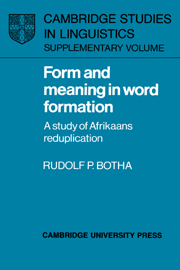5 - Metascientific retrospection
Published online by Cambridge University Press: 27 February 2010
Summary
The metascientific concern of this study has been to provide an illustration of the heuristic power of the Galilean style. Specifically, this concern has been with showing that this mode of inquiry may be profitably used to pursue depth of insight in less well researched areas, such as morphology and semantics, too. Given the characterization of this style presented in Chapter 1, the proposed analyses of the formation and interpretation of Afrikaans reduplications are clearly Galilean in nature. These analyses are Galilean in essentially two, complementary, respects: in their pursuit of theoretical unification, and in their treatment of data or “facts” that appear to pose a threat to unifying principles.
Consider first the manner in which the analyses illustrate the Galilean pursuit of depth of understanding through theoretical unification. Both the analysis of the formation and that of the interpretation of Afrikaans reduplications yielded strongly unifying theories. The theory of formation derives its unifying power from the single formation rule formulated as (2) in Chapter 2 and the various general constraints to which this rule was made subject. As regards the formation rule, it says in effect that all Afrikaans reduplications are formed in the same way, regardless of the lexical category to which these reduplications and their bases belong. To postulate only one formation rule for all Afrikaans reduplications is to say that from the point of view of their formation, these forms manifest a unitary phenomenon. As noted above, the general constraints placed on this rule constitute the second source of unifying power of the theory of formation.
- Type
- Chapter
- Information
- Form and Meaning in Word FormationA Study of Afrikaans Reduplication, pp. 158 - 161Publisher: Cambridge University PressPrint publication year: 1988



